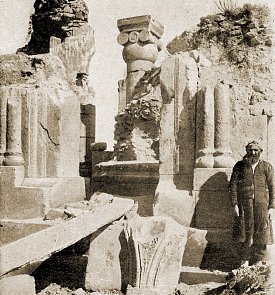Ani (Armenian: Անի; Greek: Ἄνιον Anion; Latin: Abnicum; Georgian: ანისი Anisi; Turkish: Ani) is a ruined medieval Armenian city-site situated in the Turkish province of Kars, near the border with Armenia.
Between 961 and 1045 it was the capital of the Bagratid (Bagratuni) Armenian Kingdom that covered much of present day Armenia and eastern Turkey. The city is located on a triangular site, visually dramatic and naturally defensive, protected on its eastern side by the ravine of the Akhurian River and on its western side by the Bostanlar or Tzaghkotzadzor valley. The Akhurian is a branch of the Araks River and forms part of the current border between Turkey and Armenia. Called the "City of 1001 Churches," Ani stood on various trade routes and its many religious buildings, palaces, and fortifications were amongst the most technically and artistically advanced structures in the world.
At its height, Ani's population probably reached 100,000. Long ago renowned for its splendor and magnificence, Ani was abandoned and largely forgotten in the sixteenth and seventeenth centuries. Ani is a widely-recognized cultural, religious, and national heritage symbol for Armenians.
Ani (Armenian: Անի; Greek: Ἄνιον Anion; Latin: Abnicum; Georgian: ანისი Anisi; Turkish: Ani) is a ruined medieval Armenian city-site situated in the Turkish province of Kars, near the border with Armenia.
Between 961 and 1045 it was the capital of the Bagratid (Bagratuni) Armenian Kingdom that covered much of present day Armenia and eastern Turkey. The city is located on a triangular site, visually dramatic and naturally defensive, protected on its eastern side by the ravine of the Akhurian River and on its western side by the Bostanlar or Tzaghkotzadzor valley. The Akhurian is a branch of the Araks River and forms part of the current border between Turkey and Armenia. Called the "City of 1001 Churches," Ani stood on various trade routes and its many religious buildings, palaces, and fortifications were amongst the most technically and artistically advanced structures in the world.
At its height, Ani's population probably reached 100,000. Long ago renowned for its splendor and magnificence, Ani was abandoned and largely forgotten in the sixteenth and seventeenth centuries. Ani is a widely-recognized cultural, religious, and national heritage symbol for Armenians.
Cultural and economic center
Ani did not lie along any previously important trade routes, but because of its size, power, and wealth it became an important trading hub. Its primary trading partners were the Byzantine Empire, the Persian Empire, the Arabs, as well as smaller nations in southern Russia and Central Asia.
Modern times

In 1905–06, archaeological excavations of
the church of Saint Gregory of King Gagik
were undertaken, headed by Nikolai Marr.
In the first half of the nineteenth century, European travelers discovered Ani for the outside world, publishing their descriptions in academic journals and travel accounts. In 1878 the Kars region, including Ani, was incorporated into the territory of the Russian Empire. In 1892 the first archaeological excavations were conducted at Ani, sponsored by the St. Petersburg Academy of Sciences and supervised by the Russian archaeologist and orientalist Nicholas Marr (1864–1934). Marr's excavations at Ani resumed in 1904 and continued yearly until 1917.
Large sectors of the city were professionally excavated, numerous buildings were uncovered and measured, the finds were studied and published in academic journals, guidebooks for the monuments and the museum were written, and the whole site was surveyed for the first time. Emergency repairs were also undertaken on those buildings that were most at risk of collapse. A museum was established to house the tens of thousands of items found during the excavations. This museum was housed in two buildings: the Minuchihr mosque, and a purpose-built stone building. Armenians from neighboring villages and towns also began to visit the city on a regular basis, and there was even talk by Marr's team of building a school for educating the local Armenian children, building parks, and planting trees to beautify the site.
In 1918, during the latter stages of World War I, the armies of the Ottoman Empire were fighting their way across the territory of the newly declared Republic of Armenia, capturing Kars in April 1918. At Ani, attempts were made to evacuate the artifacts contained in the museum as Turkish soldiers were approaching the site. About 6000 of the most portable items were removed by archaeologist Ashkharbek Kalantar, a participant of Marr's excavation campaigns.
At the behest of Joseph Orbeli, the saved items were consolidated into a museum collection; they are currently part of the collection of Yerevan's State Museum of Armenian History.Everything that was left behind was later looted or destroyed. Turkey's surrender at the end of World War I led to the restoration of Ani to Armenian control, but a resumed offensive against the Armenian Republic in 1920 resulted in Turkey's recapture of Ani. In 1921 the signing of the Treaty of Kars formalized the incorporation of the territory containing Ani into the Republic of Turkey.
In May 1921, the government minister Rıza Nur ordered the commander of the Eastern Front, Kazım Karabekir, for the monuments of Ani to "be wiped off the face of the earth." Karabekir records in his memoirs that he has vigorously rejected this command and it has never been carried out, but the wiping-out of all traces of Marr's excavations and building repairs suggests that the command was partially carried out.
fonte:
@edisonmariotti
#edisnmarioti
Colaboração: Agapi Yeganyan
A cidade foi nomeada depois de mil igrejas na cidade. Há muitas igrejas, que são famoso arquitecto Trdat foi T'rdat reconstruir a cúpula colapso do Hagia Sophia em Istambul. A cidade está agora parcialmente destruída na Turquia, foi a capital dos reis da época Bagratid.




Nenhum comentário:
Postar um comentário